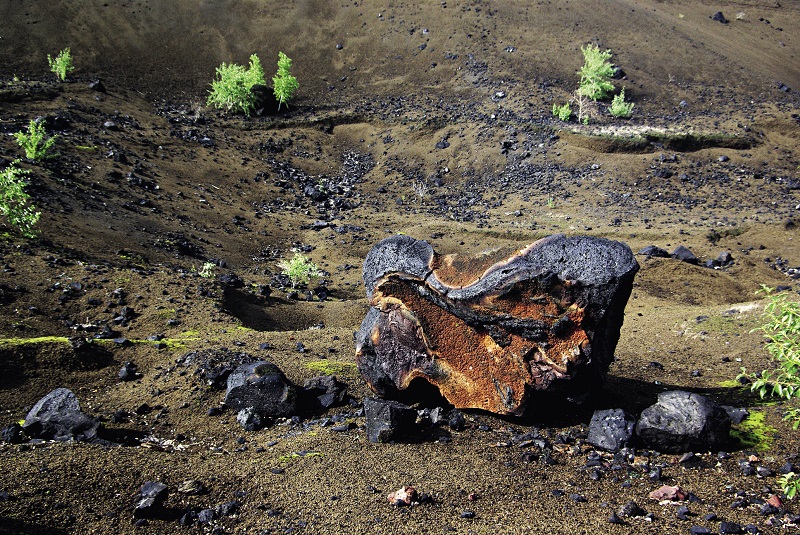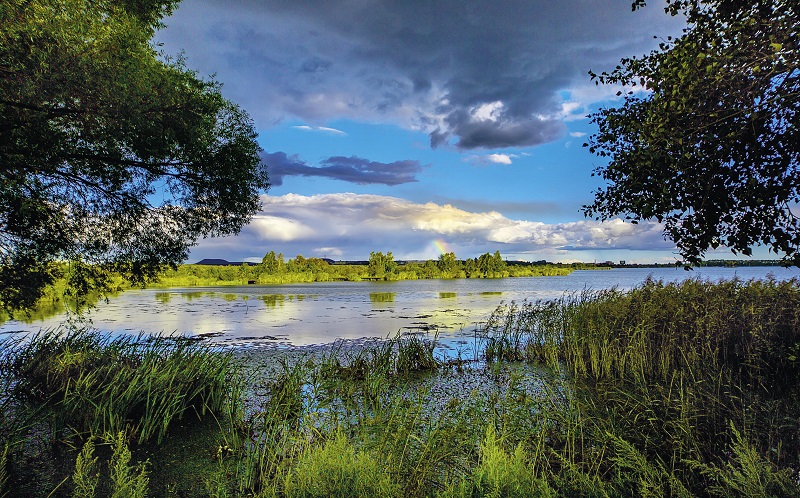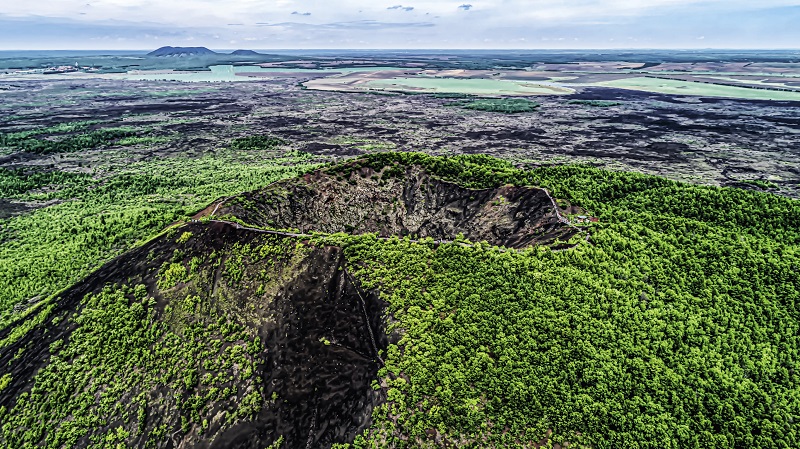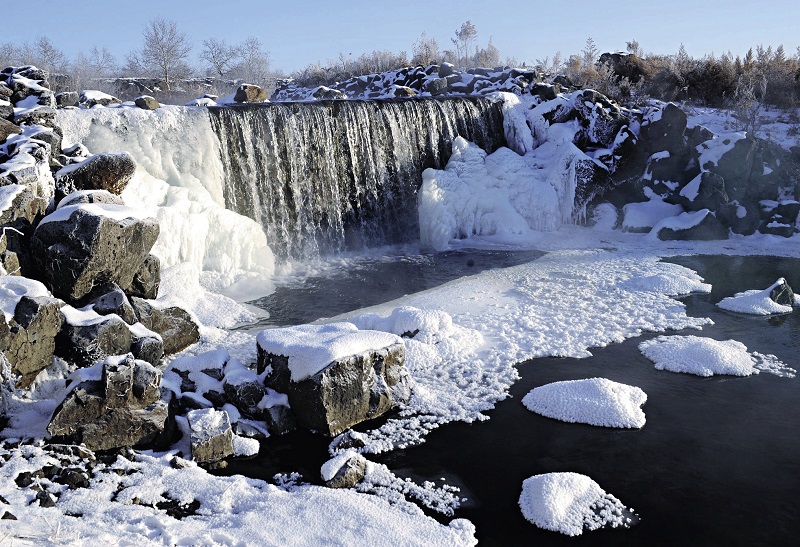In 1719, a report to the Chinese Emperor Kangxi of Qing Dynasty (1644-1911) recorded, “On the fifth day of the 12th lunar month, 15 kilometers north to the Namoer River, stones flew out from beneath the ground accompanied by a deafening sound as loud as crashing thunder. The fallen stones were fiery and turned black when the fire went out.” This report recorded a volcano eruption which lasted for 14 months, and the main player of the story, described in the official archive was the Old Black Mountain, now also known as Black Dragon Mountain. It has become a famous scenic spot in the Wudalianchi Scenic Area.
Wudalianchi is located in Heihe of China’s northeastern province of Heilongjiang. In its 1,060 square kilometer transition region between the Lesser Hinggan Mountains and the Songnen Plains, a series of 14 young and old volcanoes stand out in the mountain skyline, around which are the 800 square kilometer lava plateau and hundreds of natural mineral springs. The lava created by the eruption of young volcanoes blocked ancient rivers and formed five lava-dammed lakes which are linked together like a pearl necklace. Therefore it was named Wudalianchi, which literal means five big connected pools.
Because of its unique geological features and ecological environment, Wudalianchi has been included in the list of World Geopark, International Green List, World Biosphere Reserve, National 5A Tourist Area, National Nature Reserve, and National Forest Park.
It is often likened to a “natural volcanic museum” by scientists. However, volcanic sights are merely part of its beauty, as magic waters, lava caves, and ethnic cultures are also magnets for travelers.

Wudalianchi has a variety of lava landscapes.
Black Dragon Mountain
Wudalianchi has experienced constant volcanic geological activities dating back more than two million years to prehistoric times and continued up till more than 290 years ago in modern times, subsequently leaving behind a complete, well-preserved and diverse range of volcanic geological features. Another characteristic of these volcanoes is that they are located far from the edges of tectonic plates. Considering that most volcanoes are situated near two plates, Wudalianchi serves as a typical example of an inland monogenic volcano.
Wudalianchi is composed of 14 cone-shaped volcanoes, which stand in a “#” shape on the vast plain. They are separated by five lakes. The two young volcanoes in the west, Black Dragon Mountain and Fire Burnt Mountain, which erupted between 1719 and 1721, are the youngest in the Wudalianchi volcanic group. Together, the volcanoes form a large area of glassy pahoehoe and lava flows, lava-dammed lakes, mineral springs, and other kinds of landscape, and create the best preserved crater and volcanic micro-geomorphic remains in China.
Since the Black Dragon Mountain and the Fire Burnt Mountain are located not far from each other in the Old Black Mountain Scenic Area, tourists can visit these must-see scenic spots in one trip. There is a 20-minute shuttle bus ride that takes visitors from the entrance of the scenic area to the foot of the Black Dragon Mountain. Along the way, visitors can see black volcanic lava rocks of different shapes, and tenacious trees growing out of these lava rocks.
The Black Dragon Mountain is surrounded by a vast area of black volcanic rocks that stretches out as far as the eye can see. The cause for this amazing lava formation is that back during the time when lava was flowing, anything in its way slowed it down as the surface cooled into a plastic state, which as a result built a resistance to the lava which pushed from behind, rolled across, and became part of the lava in front. As a result, the black solidified lava surface resembles the white waves in a rough sea, thus people have also called it the sea of rocks. This sea is unique in China and rare in the world.
Following the trail, it takes about 30 minutes to reach the foot of the Black Dragon Mountain which is 515.9 meters above sea level and 165.9 meters in relative height, the crater of which is the best preserved and most typical in China. Taking into account the time needed to walk and take photos, it takes another 30 minutes to reach the crater. While climbing to the top, hikers can enjoy views of red and black volcanic rocks all along the way, and there are often squirrels waiting halfway up the mountain begging for food. At the top, visitors can admire the crater up close. The Black Dragon Mountain Crater, 350 meters in diameter and 145 meters deep, is one of the best preserved funnel-shaped craters in the world. Strolling around it, visitors can take in a stunning panoramic view of Wudalianchi.
Coming down from the Black Dragon Mountain, electric shuttle buses are available to take tourists to the neighboring Fire Burnt Mountain. The Fire Burnt Mountain’s eruption in the spring of 1721 was the finale of Wudalianchi volcanic eruptions. With an elevation of 392.6 meters above sea level and a relative height of 73 meters, the crater which has the appearance of a lotus flower when viewed from the top is 370 meters in diameter and 70 meters deep. During the wake of its eruption, an enormous amount of lava flow formed rivers of lava rocks, blocked the surrounding waters, and eventually formed a string of dammed lakes. The remains of a spectacular gorge are preserved within the crater of the volcano. In addition, around the volcano, there are rarely-seen, well-preserved driblet cones and driblet discs, which are to this day found only in small quantities in the Reunion volcanic zone in the Indian Ocean and the Dari volcanic group in Inner Mongolia. The Wudalianchi volcanic field has more than 1,500 driblet cones and thousands of driblet discs. When viewed at a distance, the scene looks like a group of black towers standing on a vast black plain. The driblet cones are generally 2-4 meters high, 2-5 meters in diameter at the bottom and hollow inside, and their inner walls are full of linear or spike-like lava stalactites.

A view of the natural landscape in Wudalianchi during autumn.
Holy Springs
Aside from magnificent volcanic landscapes, Wudalianchi is also well-known worldwide for its mineral water which has multiple health benefits.
More than 380 springs have been discovered on the exposed surface in Wudalianchi, including those of bicarbonate cold mineral water, which enjoys the reputation of being “one of the world’s three finest cold springs” along with France’s Vichy mineral spring and Russia’s Narzan mineral spring. These natural mineral springs have medicinal properties. Their healing effects are supported by sufficient scientific evidence: the water temperature maintains at 2-4 degree celsius year-round, it naturally contains a large amount of carbon dioxide gas and more than 30 kinds of trace elements and macro elements beneficial to human health. The natural ratio of these elements corresponds to what the human body needs, making it more convenient for these nutrients to be directly absorbed by human body, thus endowing the water with various properties and health benefits.
Wudalianchi encompasses five mineral water zones each rich in reserves. The Beiyao Spring is one of the five and is open to tourists. The abundance of gas in Beiyao Spring is produced by the dissolution of carbon dioxide and various minerals from the rocks deep in the earth, which gradually mineralizes the underground water, and is driven up by the pressure. Within a period of 30 to 70 years, it eventually emerges as a mineral spring when it finally reaches the earth’s surface.
This unseen brew underground gives a fascinating flavor to the spring water that will absolutely blow drinkers’ minds during their first taste. According to many personal accounts, this spring water tastes like a spicy iced coke. The stinging textures is quite a memory. Since the gas and many trace elements quickly oxidize and deteriorate the spring water when it is exposed to the open air, the spring water must be drunk as soon as possible once it is bottled, otherwise it will turn reddish the next day.
The magical effect of Wudalianchi mineral spring water was discovered by local residents thousands of years ago. An old folklore has it that many years ago a young Daur (an ethnic group in northeast China) hunter shot an arrow and wounded a deer near a spring. The wounded creature then raced to the spring and stopped the bleeding of the wound by cleaning it in the spring water. The Daur hunter immediately understood that the deer had guided him to find the sacred water, and knelt down to worship the spring. On returning home, he led his people to drink and bathe there in the spring. Those with wounds, stomach pain or sore backs quickly recovered after bathing in the water. The news soon spread to the nearby Manchu, Mongolian, Ewenki, and Oroqen people (all ethnic groups in northeast China), and they called the spring the Medicine Spring. From then on, every year people have gathered at the spring and held celebrations. Local people call it the Holy Water Festival, which falls on the fourth, fifth, and sixth day of the fifth lunar month. During the festival, people of various ethnic groups herd, hunt, drink spring water, and bath in it in the daytime, and then after nightfall arrives, they revel around bonfires, singing, dancing, and drinking. Today, the Holy Water Festival still remains an important festival for local people.

The crater of the Black Dragon Mountain in Wudalianchi Scenic Area.
Wenpo Lakes
The Wenpo scenic area is regarded by many tourists as the most picturesque attraction in Wudalianchi, an ideal spot for photography. The flat and black volcanic plain is dotted with crystal-clear lakes, the blue sky and white clouds are reflected on the surface of the water, at the bottom of the lake swirl aquatic plants in shades of green which are visible from the surface, and there are much floras on the shore. When one stops and listens intently, they can hear bubbling spring water rushing into the holes of the volcanic rocks. People are able to get immersed in the natural beauty by merely strolling along the pedestrian walkways and observing the volcano’s aquatic masterpieces.
Wenpo consists of three lakes: Coral, Golden Sand, and Jade. These lakes are characterized by two features. The first feature is their “magnetic water” qualities. According to research, the core area of the magnetic field of Wudalianchi is Wenpo where the magma is flowing underground, making it a perfect spot for environmental magnetic therapy. The other feature lies in that the spring water is always warm. Wenpo water comes from underground hot springs, where the water temperature year-round stays at about 14 oC. Even when ground temperatures reach - 30 oC, the water here will not freeze.
Sightseeing in Wenpo by boat first and then trekking is the option most people select, as more natural sights can be seen while traveling across water.

A stunning aquatic view of Wenpo in winter.
Ice Lava Cave
The caves in Wudalianchi are not located on the mountain like many other places, but sit beneath volcanic lava dozens of meters underground. In Wudalianchi, people can appreciate frost and snow in summer heat: Outside the cave, flowers are in full blossom, but inside the cave there is a frosty world. The cause for this phenomenon is a collision of ice and fire: during a volcano eruption, the top layer of lava solidifies first while the bottom layer continues to flow around until the subsequent flow is no longer supplemented. This is when underground caves are formed. And because some caves reach the permafrost layer, cave rocks are cooled, thus ice caves formed.
Today, every year in March, ice is taken from the river to make ice sculptures which are then transported to the cave. When entering the cave, tourists may feel like they are visiting an ice sculpture show. There are many rocks that have lost their edges through thousands of years of being washed. However, those round rocks are so hard and contain such a high level of iron that some stone stealers are unable to divide them with a hammer or gunpowder.
Wudalianchi, a gem nestled in China’s northeast region, is a volcanic empire not only famous for its volcanic landscapes but also well-known for its holy water which contains healing powers, picturesque lava-dammed lakes, and mysterious underground ice caves, as well as the customs of ethnic cultures that originated and flourished on this marvelous land.